In midst of the COVID-19 pandemic, protective screens are being explored on public buses to offer additional protection for both bus captains and commuters. SBS Transit has installed protective plastic screens on 6 of its buses as part of a two-week trial starting in mid-July.
The plastic shields are modelled after the ones being trialled on ComfortDelgro’s taxis. A side opening provides an unobstructed view of the bus’ left side mirror while a transparent film has been applied on the shield to minimise distraction from reflections.
The 6 buses will operate on Services 19, 28, 147, 196, 198 and 249.
| Bus Service | Bus Installed with Protective Screen |
| 19 | SBS7361M |
| 28 | SBS7488G |
| 147 | SBS7392Z |
| 196 | TBC |
| 198 | SBS7450P |
| 249 | SBS7343R |
Earlier on 23 May, Labour Member of Parliament Melvin Yong published a blog post about public transport workers during the COVID-19 pandemic and measures taken to protect them. Part of the initiatives is the installation of driver protective screens, which appears to be installed at the driver’s cabin of a Volvo B9TL (CDGE) bus.
Background:
Driver Protective Screens are installed on public buses primarily to protect Bus Captains from physical assault. In Singapore, the rollout of protective screens on public buses have been limited to small-scale trials involving the retrofitting of screens onto existing buses.
Driver Protective Screens provides a physical barrier between bus captains and commuters by isolating the driver’s cabin. These screens are typiclly used to protect drivers from assault. However, such screens can be costly to retrofit, and may interfere with the Bus Captain’s field of vision.
Some protective screens mitigate such problems by isolating the entire front dashboard of the bus behind the protective screen (as is the case in London), or utilize a camera/screen system to replace mirrors.
Retrofitting of such protective screens on existing buses also present difficulty in accommodating the placement of existing equipment. Not only do Bus Captains need to enter and exit the driver’s cab, passengers must also be able to access existing fare collection equipment. For example, in the 2018 protective screen trial, a hole had to be cut into the acrylic driver’s shield to allow passengers to reach into the coinbox.
Places that have adopted protective screens for bus drivers include London in the United Kingdom and Victoria in Australia. Many bus manufacturers offer partial or full protective screens for their driver cabs.
SBS Transit 2nd Generation shields
In November 2020, a revised design of protective shield was installed on several SBS Transit Volvo B9TL (CDGE) buses. These are:
- SBS7332Y
- SBS7369S
- SBS7431U
- SBS7432S
2018 Protective Screen trial
The possibility of trialling bus protective screens was first raised in Parliament in November 2017. The 6-month trial, which materialised in 2018, intended to test the effectiveness and feasibility of the protective screens. A total of sixteen buses were retrofitted with the screens.
Protective Screens on other buses
Yutong buses procured for the Changi Airport Terminal 4 – Terminal 2 Shuttle Buses were delivered with protective screens. Operated by Woodlands Transport, these buses commenced passenger service back in October 2017.
See Also:
- COMET MAXI: Public buses retrofitted into dedicated COVID-19 patient transport vehicles, featuring more extensive separation between Bus Captain and passengers.
External Links & References:
- 16 public buses to have protective screens for drivers in six-month trial – Today Online
- Melvin Yong: What Is the ‘New Normal’ for Our Bus Workers After Circuit Breaker? – Labourbeat
- The Straits Times – Coronavirus: Shields being considered on public buses to protect drivers and commuters
- SBS Transit Trials Protective Shields On Buses (SBS Transit)
- Covid-19: SBS Transit trials plastic shields in six buses to protect bus captains (TODAY)
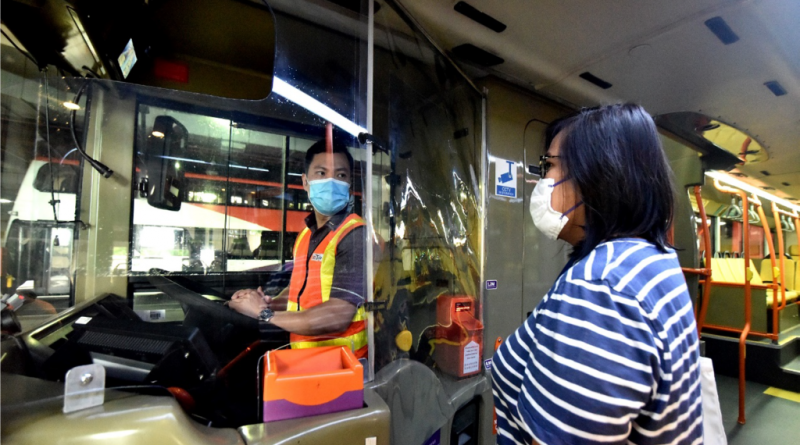
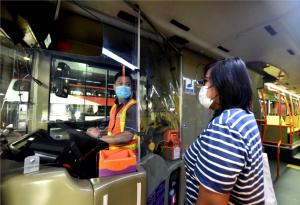
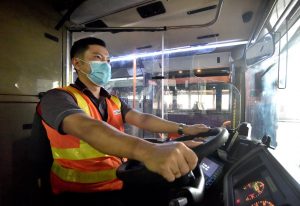
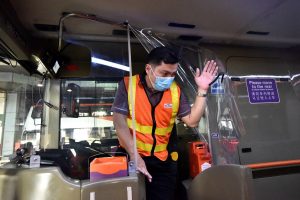
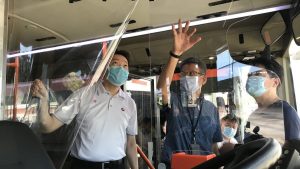
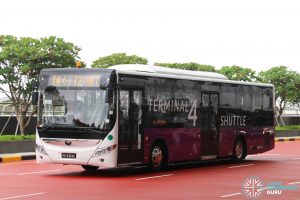
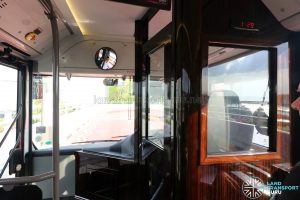
They should use the glass protective screen with anti-glare rather than plastic.
Bad idea. Glass is fragile and can injure the driver when broken by itself.
LTA should take this pandemic opportunity to spray lush green to non-lush green buses.They ought to consider early retirement for Euro III B9TLs & Euro IV K230UBs..
But I think that excludes the Scania K230UBs on cross-border fleets (160, 170, 170X) in SBS Transit’s fleet.
Please do not replace side mirrors with cameras..